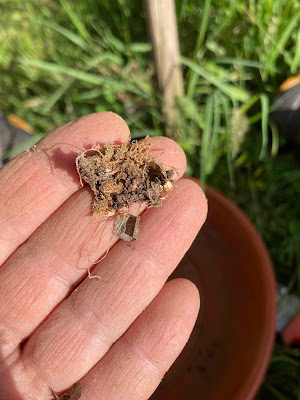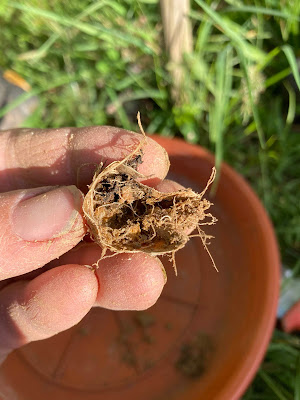We'd all love our WarblerFalls to be as sparkly clean as the day we first set them up, but the reality is somewhat, um, different.
If you're just tuning in and wondering, "What's a WarblerFall?" please go to
if only to see my two-minute video pitch for the plans to my little invention. You'll get a laugh out of it. Or maybe you'll bite, and build the world's best bubbling bird spa!
I'm going to give you some pro tips for keeping your WarblerFall clean as a whistle.
All it takes is a few mourning doves to turn a sparkly fountain into a latrine. Next to European starlings, mourning doves are the poopinest birds on the planet. And they seem to enjoy sitting on the rim, butts in, making their next deposit. And don't get me started on common grackles who, if they're nesting nearby, take pains to bring their fecal sacs to birdbaths for safe deposit. Arrgh! Thank you for keeping your nest location secret, bringing all the droppings here to fool any potential predators, and polluting everyone's water supply in the process, grackles.
Keeping the WarblerFall clean is a challenge when lots of birds are using it. When the temperatures are warm, green and brown algae can grow seemingly overnight, especially with the high nitrogen content of poopy water. Birds avoid slimy rocks, seeming to know they're unhealthy. And who wants to look at this? Not me!
I made a couple of mistakes with my first WarblerFall basin. Everything was groovy for awhile, and then it wasn't. I used Comet and a wire brush on the stubborn green algae that grew in it, and wound up deeply scoring the plastic basin. This in turn made little valleys for algae to grow in, and I couldn't get it out of those scratches. Ugh! Now that's groovy. And grody. I have to remember that it's only plastic, and it can't take that rough Zick-style scrubbing. This northern cardinal is enjoying a just-cleaned bath, but that green you can see around him is algae that lingers, even after a good cleaning, in the scratches in the old basin. My bad!

So I advise that you use only a nylon scrub brush--avoid metal. I like scrub brushes with long handles (made for pots and pans) as opposed to the classic scrub brush that you grab with your hand. And see if you can get it clean just by scrubbing and rinsing it, without using a powdered cleanser like Comet or Ajax. Wire brushes and powdered sink cleansers abrade the surface and ultimately give more lodging surface to algae.
I use Kaboom foam cleanser now. It does a number on the algae and turns from a fabulous shade of purple to white when you spray it. Kaboom, scrub, rinse, you're done.
If you really want to save yourself some work, buy another basin that you can switch out to when the first one gets gross. With a clean basin in reserve, you can get the bath up and running again immediately. You can then clean the gross one at your leisure, and set it out in the sun to kill any remaining algae after you scrub it.
Here's my second hack. Get yourself more rocks. LOTS of rocks. When you take the slimy ones out, lay them out in the hot sun for a week or so and let it clean them--no scrubbing required. Switch out the slimy ones for a stack of clean ones, and you're ready to rock with a sparkly clean bath.
Once you've seen how much the birds enjoy a clean bath, you won't want to let it get slimy green again.
A sweet blue jay sips off the topper rock.
I know many of us aren't fond of brown-headed cowbirds, but look at this juvenile figuring out how to take its first shower. The ideal Warblerfall has a gentle but noisy stream of burbling water, and a variety of depths of water--nothing over an inch deep. I like to cover the entire bottom of the basin with flat rocks.
The little cowbird walks right up to the stream, and lets it hit its chest.
That was fun! Now I'm going under...
I've never seen any bird but a cowbird use the WarblerFall this way. It's completely submerged and loving it!
While I'm giving tips, let me answer an FAQ. YES, you can elevate your WarblerFall to protect it from small mammalian predators. Mine are chipmunks, who try to jump on bathing birds and eat them. I had to elevate my WarblerFall about 20", placing it on an overturned terra cotta planter. Problem solved.
As a corollary, you can also put your WarblerFall on a raised deck or balcony. The birds will find it.
If you've been meaning to treat yourself to a WarblerFall, do it now. You'll have it in place for the hottest part of the summer. And fall is when the WarblerFall really shines. Autumn can be very dry, and migration is thirsty work. I'm so excited for all the people who have their WarblerFalls in place, who will experience their first fall migration with the best little birdbath going.
Please note: If you don't get your WarblerFall welcome email right away upon ordering, check your SPAM file! My outgoing email has links in it, and many email filters see those and toss it into SPAM.
If you still can't find it there, email me at
julieATjuliezickefooseDOTCOM
(putting it in proper format first, of course)
and I will sent you your plans forthwith!
A huge and heartfelt thank you to all of you who've ordered the WarblerFall plans; to those who've emailed me with great photos of birds using their new bath; to everyone who has supported me on this fun journey. A special shoutout to my friend Briana in Michigan, who curates amazing backyard songbird content at
Thanks in part to Briana's bubbling fountain of beautiful videos of her setup, The WarblerFall is going to help me build a real greenhouse, and that is pretty darn wonderful!
I am grateful, so grateful.































Saturday, June 24, 2023
0 comments